The Internet of Money: Understanding Today's Online Financial Landscape
Remember when money was just physical cash or a number in a bank's ledger? That world is rapidly receding into history.
- Ornella Jameson
- Jun 02, 2025
- 0 Comments
- 2493 Views
We live in 'The Internet of Money' – a vast, interconnected digital landscape where transactions happen at the speed of light, cryptocurrencies redefine value, and innovative online platforms are challenging traditional finance. You've come to the right place if you're ready to make sense of this new financial frontier and understand how your money moves, grows, and exists in the digital age.
The Rise of Cashless Transactions
Physical cash is becoming increasingly obsolete, as more people rely on digital wallets, tap-to-pay systems, and contactless transactions. The shift towards cashless payments is driven by three key factors: convenience, security, and global accessibility.
Tap-to-pay, QR codes, and mobile wallets make transactions instant and hassle-free. Services like Apple Pay, Google Wallet, and Venmo dominate the market, while new startups continue to innovate with AI-powered budgeting features. Additionally, digital payments reduce theft and fraud risks, offering encrypted security features that protect financial data. With cross-border payments becoming easier, cashless finance empowers people to make global transactions without the need for traditional banking intermediaries.
AI and Smart Banking: Managing Money Effortlessly
Artificial intelligence revolutionizes personal finance by providing automated budgeting, real-time fraud detection, and AI-driven financial planning. Innovative banking tools use machine learning to analyze spending patterns and offer personalized recommendations.
Apps like Cleo and YNAB help users manage budgets by tracking expenses and suggesting saving ways. Automated savings platforms set aside small amounts of money based on spending habits, making it easier to build wealth without conscious effort. Additionally, AI-powered fraud detection systems monitor transactions in real time, preventing unauthorized access and reducing the risk of cybercrime.
Cryptocurrency and the New Era of Investing
Cryptocurrency has evolved from a niche investment to a mainstream financial asset. Young investors are increasingly turning to crypto, NFTs, and DeFi platforms as alternatives to traditional banking.
Major retailers now accept Bitcoin, Ethereum, and stablecoins for everyday purchases, making crypto more accessible. Beyond digital currency, NFTs (non-fungible tokens) are being used for more than just art - companies are integrating them as digital memberships, event tickets, and exclusive rewards. Meanwhile, DeFi platforms allow users to bypass banks by lending, staking, and earning passive income through blockchain-based financial systems.
Financial Education for the Digital Age
As finance becomes more digital, financial literacy is more crucial than ever. Schools, online courses, and fintech apps are adapting to teach young people how to navigate this new economy.
Key topics in modern financial education include managing digital investments, understanding the risks of online transactions and scams, and strengthening cybersecurity practices. With AI and blockchain shaping the future of money, individuals who stay informed will be better equipped to thrive in the evolving financial landscape.
As digital money becomes the norm, young people must embrace financial literacy to navigate this new era of online finance. From AI-powered banking to cryptocurrency investments, understanding digital transactions will be essential for making wise financial decisions in 2025 and beyond.

 | Unlock Success with Our Guide
| Unlock Success with Our Guide



0 Comments